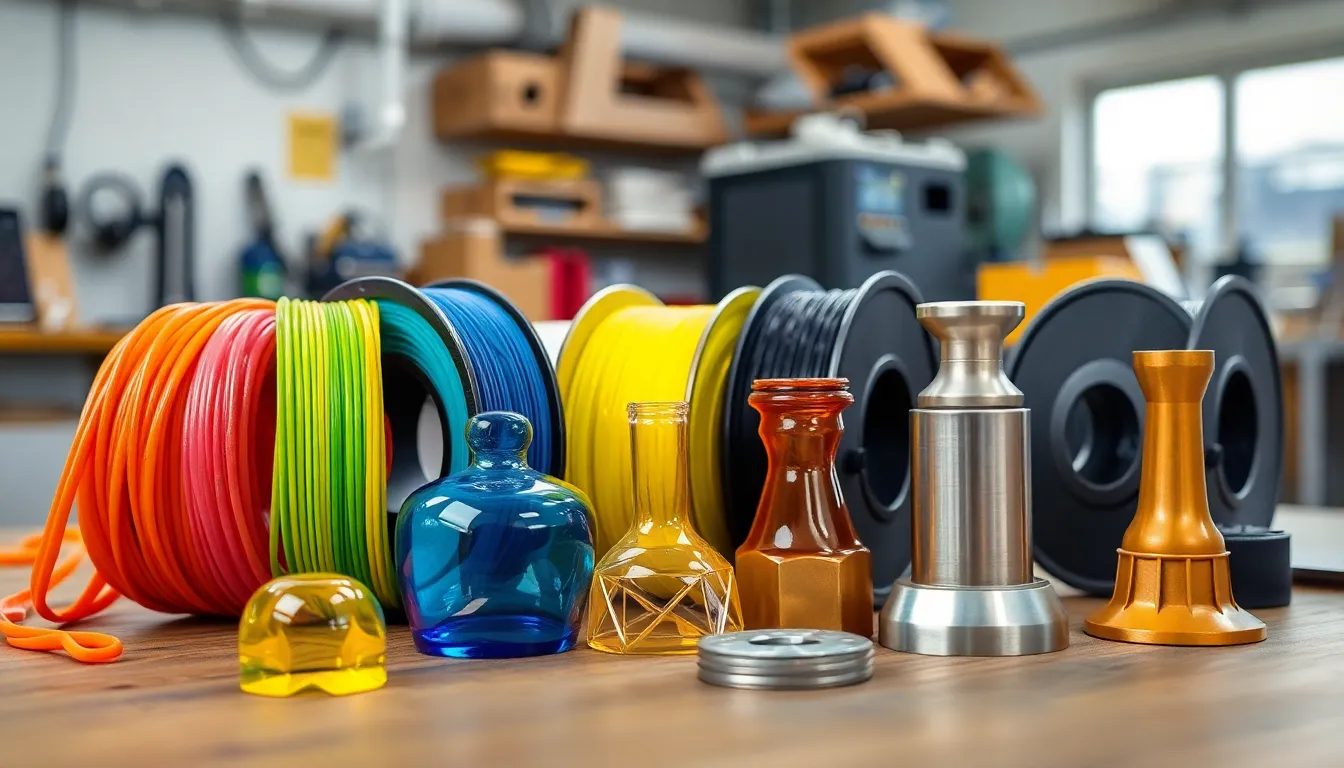In a world where creativity knows no bounds, 3D printing materials are the unsung heroes fueling innovation. From the humble beginnings of plastic filament to cutting-edge composites, these materials are revolutionizing everything from hobbyist projects to industrial applications. Imagine printing your own custom tools or even a life-sized replica of your cat—yes, it’s possible!
Table of Contents
ToggleOverview of 3D Printing Materials
3D printing materials vary greatly, impacting the outcome and functionality of printed objects. Plastics, including filament types like PLA and ABS, represent the most commonly used materials. Due to their affordability and versatility, these plastics are favored by hobbyists and professionals alike.
Metals, such as titanium and aluminum, offer strength and durability for industrial applications. Their ability to withstand stress makes them suitable for aerospace and automotive industries. Ceramics present another option, providing high heat resistance and aesthetic finishes, often used for artistic projects and intricate designs.
Composite materials combine properties from various substances, enhancing performance characteristics. For example, carbon fiber-reinforced filaments deliver improved strength while remaining lightweight, appealing to engineers and designers. Specialty materials, like flexible TPU, add unique features for items requiring elasticity, such as phone cases or wearables.
Each material type offers distinct advantages and limitations, so selection depends on the specific project requirements. Users should consider factors such as print speed, object strength, and finished appearance when choosing materials. Knowledge of these attributes aids in optimizing the 3D printing process, leading to successful outcomes.
Emerging materials continue to push boundaries in 3D printing. Innovations include biodegradable filaments and metals with enhanced properties, fostering sustainability and new possibilities. Understanding these developments empowers creators to explore diverse applications, turning concepts into tangible creations effectively.
Types of 3D Printing Materials

3D printing involves a variety of materials, each suited for different applications. Familiarity with these materials enhances project success.
Thermoplastics
Thermoplastics dominate the 3D printing landscape due to their accessibility and ease of use. PLA and ABS rank among the most popular choices. PLA offers a biodegradable option, perfect for environmentally conscious projects. ABS provides higher durability and temperature resistance, making it suitable for functional prototypes. Filaments come in a range of colors, allowing for customization in design. Additionally, PETG blends the best features of both, providing strength and flexibility.
Resins
Resins are essential for high-resolution printing, particularly in SLA and DLP technologies. Standard resins yield smooth surfaces and intricate details, ideal for jewelry and miniatures. Tough resins enhance durability and impact resistance, suitable for engineering prototypes. Flexible resins cater to the need for stretch and bend in certain applications. Specialty resins, including castable and odorless versions, broaden usability in various fields. They require UV curing for solidification, offering precise results.
Metals
Metals serve critical functions in industrial 3D printing. Titanium stands out for its strength-to-weight ratio, commonly used in aerospace and medical applications. Aluminum offers lightweight properties and excellent thermal conductivity, often used in automotive components. Stainless steel provides corrosion resistance and is ideal for functional parts. Copper excels in electrical conductivity, useful for a range of electronic components. Selective laser melting and electron beam melting are primary techniques for metal 3D printing, ensuring precision and integrity.
Composites
Composites combine thermoplastics with reinforcing materials for enhanced performance. Carbon fiber reinforced filaments are lightweight yet extremely strong, suitable for aerospace and automotive applications. Glass fiber composites offer improved rigidity and impact resistance, often used in industrial parts. Nylon composites incorporate flexibility and strength, making them great for functional prototypes. These materials provide unique properties that cater to various engineering challenges. Utilization of composite technology significantly broadens design capabilities in 3D printing.
Factors to Consider When Choosing 3D Printing Materials
Choosing the right 3D printing material involves several vital factors. These elements impact the finished product’s quality, functionality, and overall success.
Strength and Durability
Material strength plays a crucial role in the selection process. PLA provides adequate strength for everyday items, while ABS excels in durability and withstands higher temperatures. For industrial applications, metals like titanium or aluminum deliver exceptional strength. Each material’s resilience affects its suitability for specific tasks, influencing how well the final object performs under stress or environmental challenges.
Flexibility and Elasticity
Flexibility needs vary widely across projects. Flexible materials like TPU offer significant elasticity, allowing creation of objects that bend and stretch. Such flexibility is necessary for items like phone cases or wearable tech. More rigid materials suit applications requiring precise dimensions without deformation. It’s important to identify the desired characteristics in the final product, which helps determine the appropriate balance of flexibility and rigidity.
Cost and Availability
Cost considerations are essential when selecting materials. PLA typically costs between $20 to $30 per kilogram, making it a budget-friendly option for hobbyists. In contrast, specialty materials often carry higher price tags, such as flexible filaments or metal powders. Availability also influences choices; common materials have widespread supply, while niche options may require specialized sourcing. Balancing budget constraints alongside project needs paves the way for efficient material selection.
Future Trends in 3D Printing Materials
Emerging trends in 3D printing materials highlight continued innovation and broadened applications. Biodegradable materials gain traction as sustainability becomes a priority. Companies invest in developing eco-friendly filaments made from materials like plant-based sources.
Researchers explore new polymer blends to improve material performance. Enhanced resilience in plastics leads to longer-lasting products, while flexible materials provide versatility in design. Moving beyond traditional options, bio-based resins are gaining popularity for their reduced environmental impact.
Advancements in metal 3D printing show promise for industries like aerospace and automotive. Lightweight metals such as aluminum aid in reducing overall product weight while maintaining strength. Titanium remains favored for its durability in demanding environments.
Moreover, composite materials present evolving possibilities. Engineers combine carbon fiber and plastics to create lightweight and strong parts suitable for high-stress applications. Various industries prioritize these composites for their unique performance characteristics.
Specialty materials continue to push boundaries in design and functionality. Flexible thermoplastic polyurethane (TPU) enables the creation of custom goods that bend and stretch. New rubber-like materials offer a tactile feel while maintaining structural integrity.
Innovations in printing techniques also contribute to materials development. Multi-material printers allow for combinations that weren’t feasible before, combining the strengths of different substances. This trend fosters creativity, enabling more complex and efficient designs.
Future trends in 3D printing materials encompass a diverse array of innovations that support sustainable practices and enhance product performance. Material selection will play a critical role in shaping the next generation of 3D printed products across various industries.
The evolution of 3D printing materials has opened up a world of possibilities for creators and industries alike. As technology advances the range of materials continues to expand offering unique properties that cater to diverse needs. From biodegradable options to robust metals and innovative composites the right material can make all the difference in achieving project goals.
Sustainability and performance remain at the forefront of material development paving the way for eco-friendly solutions and enhanced capabilities. As new materials and techniques emerge the future of 3D printing promises to be dynamic and impactful. Embracing these advancements will empower users to push the boundaries of creativity and innovation.



